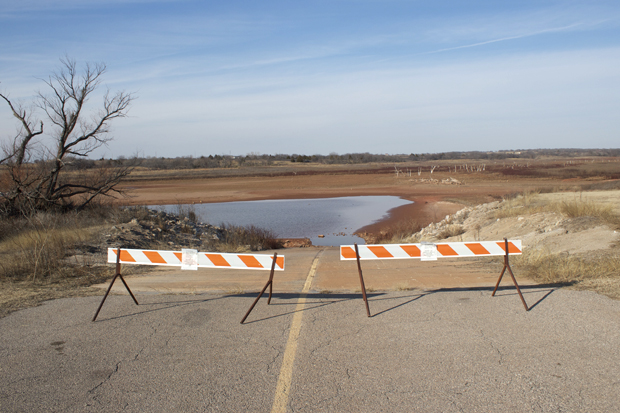
In January 2015, drought stricken Waurika Lake was dangerously low.
Logan Layden / StateImpact Oklahoma


In January 2015, drought stricken Waurika Lake was dangerously low.
Logan Layden / StateImpact Oklahoma

Logan Layden / StateImpact Oklahoma
The dry boat ramp at the Chisholm Trail Ridge Campground on the eastern shore of Waurika Lake in Jan. 2015.
Lawton is pulling out all the stops in its battle with the ongoing drought in western Oklahoma. Last week, StateImpact reported on the city’s plan to create more rain through cloud-seeding. Now Lawton is moving forward with a project to dredge built up silt from the bottom of Waurika Lake that’s clogging pumps and making what little water is left in the lake harder to access.
The lake serves as a secondary water source for Lawton, but the sole water source for Duncan.
As KSWO’s Darcy Jackson reports, the estimated $12 million price tag would be even higher if the lake weren’t so low:
It’s a massive makeover for Southwest Oklahoma’s drinking water, something that lake manager Dave Taylor says has been in the works with managers and the U.S. Corps of Engineers for over a year.
“We want to make sure we have a reliable water supply in the remaining years of this drought and that project will ensure that it’s a sustainable water supply,” said Taylor.
… “The dredging and the gate repair is really not optional. It has to be done sometime and it saves money by doing it now while the lake is low,” explained Taylor.
Waurika Lake is less than 30 percent full, and Lawton isn’t the only community that relies on it for drinking water:
So, the master conservatory is asking the same cities who helped build the lake 30 years ago to now maintain it. With Lawton paying 60 percent, Duncan will pick up around 33 and the remaining will be split among the rest. It’s a plan officials believe will see Southwest Oklahoma through the historic drought.
All man-made lakes have a lifespan, and silting becomes a problem for many as they approach their expiration date. Dredging is an effective, but expensive way to keep older lakes alive.
Waurika is only a few decades old, but in that time silt has piled up on the lakebed and around the pumps that move water out. Waurika Lake is being pinched from below — because of the silt situation — and above — where evaporation is being exasperated by years of drought.
The U.S. Army Corps of Engineers still has to approve the Waurika dredging plan, but the project is expected to begin in June.